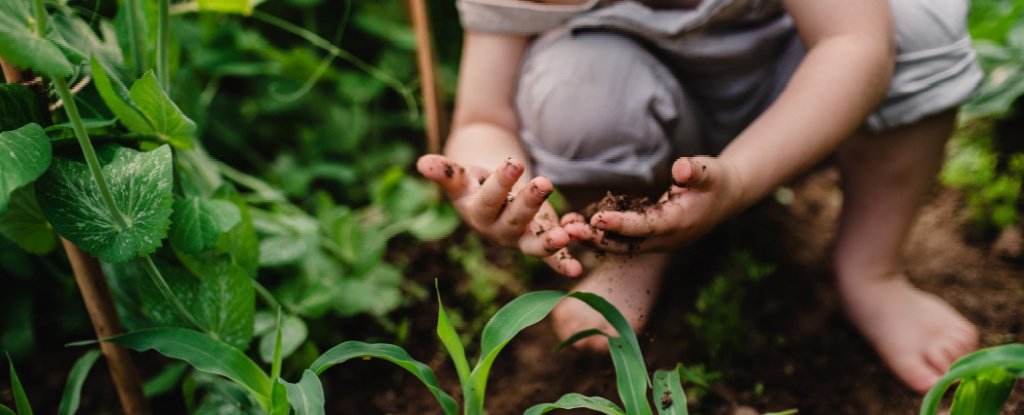
According to a Finnish experiment, one month of playing in the undergrowth and greenery of a mini forest may be enough time to improve a child's immune systems.
Daycare workers laid a lawn and planted undergrowth, such as dwarf heather or blueberries, and let children care for the crops in planter boxes. The diversity of microbes found in young children's guts was evident in a short time.
Comparable to children who attend standard urban daycares that have yards of asphalt, tile, and gravel, the 3-, 4- and 5-year-olds from these greened up daycare centers in Finland had higher levels of T-cells and other immune markers within 28 days.
Marja Roslund, an environmental scientist at the University of Helsinki, stated that "We also discovered that the intestinal microbiota of kids who received greenery was very similar to that of children who visit the forest every day." The research was published in 2020.
A daycare before and after the introduction of grass and planters (left). (University of Helsinki).
Research has previously shown that early exposure to green spaces is linked to an immune system functioning well. However, it is still unclear if this relationship is causal.
Finland's experiment is the first to specifically manipulate children's urban environments and test for changes in their microbiome, which in turn tests for changes in a child’s immune system.
Although the results don't provide all the answers they need, they support the idea that environmental microbes can easily alter the microbiome of children and give their immune system an extra boost.
"Biodiversity hypothesis" is the theory that an environment rich with living things can impact our immunity. According to this hypothesis, the recent rise of immune-related diseases could be partially or entirely caused by a decrease in biodiversity in urban areas.
The study's authors stated that "the results of this study support biodiversity hypothesis" and suggested that low biodiversity in modern life environments may cause an un-educated immune response and increase the incidence of immune-mediated disease.
The study examined the environmental microbes that were found in the yards and gardens of ten different urban daycares caring for 75 children between the ages three and five.
Some daycares had standard urban yards with concrete or gravel. Others took children out for nature time and four others had their yards updated by grass and forest undergrowth.
The children in the four last daycares had time to play in their backyard five times per week for 28 days.
Researchers tested the microbiota in their skin and gut before the trial and after it. They found better results than the children who were exposed to less greenery and had been at daycares for longer periods.
Researchers found that microbes in the skin and guts from children who play in green spaces were more diverse than those who did not. This feature is linked to a healthier immune system.
They largely matched the results of the second group of daycare children who went on outings for daily nature times.
Gammaproteobacteria, a microbe found in soil, grass, and trees, was seen to increase the skin's immune defense. It also increased blood immune secretions and reduced interleukin-17A levels, which are linked to immune-transmitted disease.
Sinkkonen stated that this supports Sinkkonen's assumption that nature contact prevents the development of immune disorders such as allergies and autoimmune diseases.
These results are not conclusive, and will need to be confirmed by larger studies across the globe. The benefits of green spaces seem to extend beyond our immune system.
Research has shown that getting outside can improve a child's vision and help with mental health. Recent studies show that green spaces can be linked to brain structural changes in children's brains.
It isn't yet clear what is driving these amazing results. This could be due to changes in the immune system or breathing healthier air, getting more sun and exercising more or feeling more peaceful.
Because of the complexity of the world, it is difficult to account for all environmental factors that can impact our health.
Although rural children are less likely to experience allergies or asthma, there is not much literature available on the connection between green spaces and immune disorders.
Although the research was limited in sample size and could not account for children's activities outside of daycare hours, scientists in Finland were able to see positive results that allowed them to make some suggestions.
Aki Sinkkonen, an environmental ecologist from the University of Helsinki, stated that "It would have been best if children could playin' in puddles" and that everyone could dig organic soil.
"We could take our kids out to the nature five times per week to make an impact on microbes."
The benefits are numerous, the risks are low and the changes are easy.
It is good for our planet's future to bond with nature as children. Research shows that children who spend more time outside are more likely than adults to desire to be environmentalists. This is especially important in an ever-changing world.
Sinkkonen advised that everyone be up-to-date on their tetanus vaccines.
Science Advances published the study.
This article was previously published in October 2020.
